Map of Famous Homes to Visit Around the World
Map of Famous Homes to Visit Around the World
Homes are popular. Architecture, decor, renovations, home flipping, building a home. Seriously, just add the word “home” to pretty much anything and you will increase interest. People enjoy seeing how others live, understanding how people lived in the past, and looking for ways to increase comforts in their own homes.
The one thing that people like to do the most is look at homes. Whether searching the web, driving in a nice neighborhood or traveling to see the residence in person, we all like to get a glimpse into what others have done to make their homes so amazing, beautiful, interesting or downright weird.
Since traveling (among other things) is not exactly easy now, we thought we’d bring the homes to you. We put together a list of houses around the world to consider visiting. Whether you’re taking a virtual tour, learning interesting facts, or adding them to your “places to see” bucket list before you die, these places won’t disappoint.
Be sure to check back often because we will constantly be updating our list. So pour yourself a cup of coffee (tea, wine, scotch, whatever your beverage of choice) and enjoy our collection of famous castles, unusual architecture and some of the coolest houses in the world!
World Map of Houses to See
Click on the location below to see details and a short summary of each house. Click on the link within the details to view further information on the architecture and history.
United States — By State
Alaska
Baranov Museum / Kodiak History Museum | Kodiak, AK
Year Built: 1810
Architectural Style: Traditional Russian Horizontal Log
Architect/Designer: Russian American Company
Original Owner: Russian American Company
Other Notable Owners: Alaska Commerical Corporation, W.J Erskine
From Russia, With Love: Step Inside the Oldest Standing Building in Alaska
While searching for valuable otter pelts in the late 18th century, Russian explorers built a storage facility on Kodiak Island. At the time, it was a practical place to store their supplies and their bounty, but they had no idea that this building would stand the test of time and ultimately become the oldest standing building in Alaska.
Known as the Baranov Museum or Kodiak History Museum, the building is a popular attraction for both local residents and visitors alike.
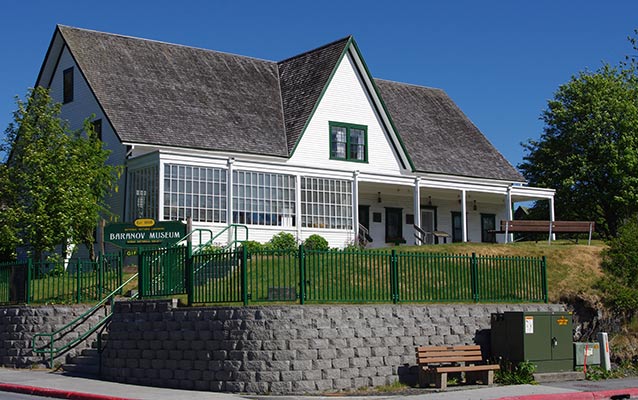 Present-day photo of the Baranov Museum / Kodiak History Museum in Kodiak, Alaska.
Present-day photo of the Baranov Museum / Kodiak History Museum in Kodiak, Alaska.Image: National Park Service
The museum itself is dedicated to the expansive history of Kodiak. There are artifacts on display from Alutiiq and Aleut tribes that first called this land home, as well as exhibits dedicated to the important role the crabbing industry played on the island in the late 20th century.
Some people refer to the building as the Russian American Magazine or the Erskine House, but regardless of what it's called, it is an important symbol to those who live in the community. The property and the museum housed inside is a living tribute to the formidable people of Kodiak Island.
Arizona
Taliesin West | Scottsdale, AZ
Year Built: 1937
Architectural Style: Organic Architecture
Architect/Designer: Frank Lloyd Wright
Original Owner: Frank Lloyd Wright
Glimpse Over the World's Rim at Taliesin West
Made famous for his architectural designs that blended modern construction with organic nature, Frank Lloyd Wright had the opportunity to create dozens of homes and buildings in his lifetime. However, no property held more personal value to the architect than Taliesin West.
The winter home and desert laboratory of Frank Lloyd Wright, Taliesin West was designed to emerge from the desert land where it was built. Today, this property is a UNESCO World Heritage Site and a National Historic Landmark, and a museum in Scottsdale, Arizona, that is open for public tours.
 Frank Lloyd Wright’s Taliesin West blends modern construction with nature.
Frank Lloyd Wright’s Taliesin West blends modern construction with nature.Image: Taliesin West in Scottsdale, Arizona. Courtesy of the Frank Lloyd Wright Foundation.
Not only does a visit to Taliesin West allow you to experience the iconic architectural style of Frank Lloyd Wright, but it also provides valuable insight into his commitment to the community at large. When you tour this home and school, you learn more about how Wright imparted his wisdom to his apprentices, who helped him build Taliesin West from the ground up. With Mid-Century Modern inspiration, it’s one of the best examples of Wright's architectural accomplishments and also provides the most comprehensive information about his life and times.
Sources/Resources:
Arkansas
Johnny Cash's Boyhood Home | Dyess, AR
Year Built: 1934
Architectural Style: Country Ranch
Architect/Designer: Dyess Colony (a New Deal Work Progress Administration project)
Original Owner: Ray and Carrie Cash
Other Notable Owners: Arkansas State University
“Walk The Line” Where Johnny Cash was Raised
Nearly any American can sing the lyrics of "I Walk the Line" or "Ring of Fire," but most people cannot tell you where Johnny Cash was raised or what his early years were like.
Fortunately, it's easy to discover this iconic singer's past when you visit the Johnny Cash Boyhood Home, located in the Historic Dyess Colony. This colony — created by Franklin D. Roosevelt's New Deal — has been preserved to tell the stories of the Arkansas farmers who relocated to the community to restart their lives after the devastating impacts of the Great Depression.
 Johnny Cash’s boyhood home in Dyess, Arkansas, has been restored to its original country ranch style — right down to the flower boxes and porch railings.
Johnny Cash’s boyhood home in Dyess, Arkansas, has been restored to its original country ranch style — right down to the flower boxes and porch railings.Image: 166939684 © Joe Sohm - Dreamstime
It was here in this spartan colony where Johnny Cash was raised. Visitors can go to the house he lived in, with the furnishings as they were when the Cash family resided there. By stepping into the home where he came of age, Johnny’s greatest fans can better understand and appreciate his music.
When you take a tour of the colony, you will begin to connect with this famed musician on a new level while simultaneously learning about an exciting chapter of American history.
Sources/Resources:
California
Hearst Castle | San Simeon, CA
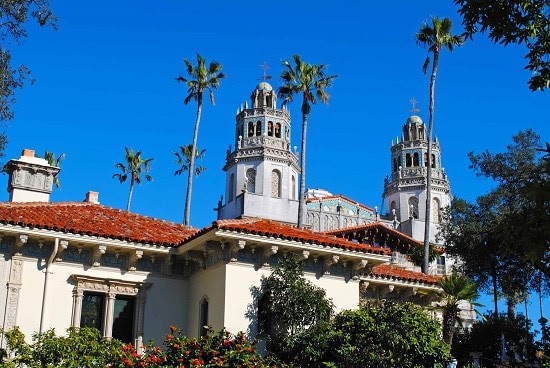 Designed by Julia Morgan for William Randolph Hearst, the Moorish-style mansion is one of California's most iconic homes.
Designed by Julia Morgan for William Randolph Hearst, the Moorish-style mansion is one of California's most iconic homes.Image: 119675120 © Alyssand - Dreamstime
Year Built: 1919-1947
Architectural Style: Spanish Colonial Revival, Mediterranean Revival
Architect/Designer: Julia Morgan
Original Owner: George Hearst (purchased the ranchland in 1865); William Randolph Hearst (built the house and expanded the property)
Other Notable Owners: State of California
Hearst Castle: “A Little Something” for W.R. and His Mistress
Once owned by newspaper tycoon William Randolph Hearst, Hearst Castle in San Simeon is now a California State Park. Designed by one of the country’s first female architects, Julia Morgan, the Moorish-style mansion, where movie stars basked in the gold-and-Venetian-blue Roman Pool, is one of the most iconic estates on the California coast. Tours showcase the grand rooms and Hollywood’s 1920s Golden Age history.
Not to be missed are the Spanish-style bedroom suite with attached gothic library, complete with period murals; the assembly room where Hearst and his mistress, actress Marian Davies, received celebrity guests; the Prohibition-era
wine cellar where Hearst's private collection was stashed in vaults; the Neptune pool backed by Grecian colonnades; and the "bear pits" that remain from the old zoo. As you explore the estate, you'll learn about Hearst's family and the larger-than-life personalities who graced the coastal castle
For those familiar with the movie Citizen Kane by Orson Welles, you just might see some similarities between the outrageous Kane and his palace Xanadu and the outlandish Hearst and his castle — who was rumored to be the inspiration for the film. Fortunately for us, Hearst Castle has been preserved for future generations to enjoy. Descriptions of every tour and additional information are on the website.
Sources/Resources:
The Painted Ladies | San Francisco, CA
 When in San Francisco, be sure to visit The Painted Ladies at Alamo Square. These Edwardian and Victorian homes stand out with their color paint and extensive architectural details.
When in San Francisco, be sure to visit The Painted Ladies at Alamo Square. These Edwardian and Victorian homes stand out with their color paint and extensive architectural details.Image:ID 146730220 © Minnystock | Dreamstime
Year Built: 1892-1896
Architectural Style: Victorian and Edwardian
Architect/Designer: Matthew Kavanaugh
Original Owner: Multiple owners
See the Beauty of San Francisco's Painted Ladies for Yourself
“Everywhere you look, everywhere you go…” you will likely be on the lookout for the Painted Ladies of San Francisco. These iconic Victorian and Edwardian homes served as the backdrop for the famous "Full House" theme song, but they have long been a treasured tourist attraction in the city.
Built between 1892 and 1896, the Painted Ladies were not always the pretty pastel homes that today's travelers recognize instantly. When initially constructed, the houses were different colors, but in the 1960s, the owners decided to repaint the houses to highlight their exterior architecture’s incredible details. The effect worked, and it made these homes stand apart from the rest of the 48,000 other Victorian homes in the city.
Today, the Painted Ladies are privately-owned residences, but that doesn't stop people from around the world from heading to "Postcard Row" in Alamo Square to get a photograph with these homes in the background. This spot is one of the most well-known historical landmarks in the entire city, and it's not uncommon to see tourists running up the hill as if they are a part of the famous 1990s TV sitcom.
Winchester House | San Jose, CA
Year Built: 1886-1922
Architectural Style: Queen Anne Victorian
Architect/Designer: Sarah Winchester
Original Owner: Sarah Winchester
Other Notable Owners: John & Mayme Brown (1922-51)
Winchester Mystery House: Is it Haunted?
Eccentric? Cursed? A visionary? For nearly 40 years until her death in 1922, a young widow and heir to the Winchester Repeating Arms fortune embarked on a continuous and mysterious succession of improvements to what was originally an eight-room California farmhouse.
Drowning in grief following her husband’s death, Sarah Lockwood Pardee Winchester consulted a spiritualist who convinced Sarah she was cursed by the spirits of those killed by Winchester rifles. To escape those spirits, she must build — and continually build — a new home for herself and those spirits out West.
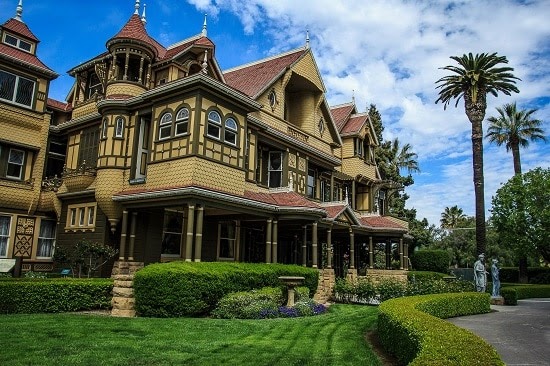 With doors that lead to walls and stairs to nowhere, the Winchester House leaves us with so many unanswered questions. A tour inside helps to shed light on the woman behind its construction, Sarah Winchester.
With doors that lead to walls and stairs to nowhere, the Winchester House leaves us with so many unanswered questions. A tour inside helps to shed light on the woman behind its construction, Sarah Winchester.Image: Winchester front exterior. Courtesy of Winchester Mystery House.
Sarah settled on a small cottage in San Jose, California, and began alterations in earnest in 1884. Over 38 years of virtually non-stop construction, the home grew into a turreted mansion in the American Queen Anne Revival style, which in today’s configuration contains 160 rooms spread over 24,000 square feet.
The home’s design contains many unusual and even bizarre features. With over 10,000 windows, 2,000 doors, 17 chimneys, 13 bathrooms, and six kitchens, there is so much that remains unexplained. Doors open onto walls. Multiple staircases lead to nowhere. Even a room with no doors! The motif of the number ‘13’ can be found in architectural elements throughout much of the house. But why?
To this day, the mansion is considered by many to be haunted and a site for paranormal activity, attracting more than 12 million visitors since it opened to the public in 1923. Sarah’s renovations originally cost $5 million; today, the house is valued at $71 million. A very private person in life, all the reasons driving Sarah Winchester on this eccentric renovation remain unknown.
Sources/Resources:
Colorado
Molly Brown House | Denver, CO
Year Built: 1887
Architectural Style: Queen Anne and Richardsonian Romanesque
Architect/Designer: William Lang
Original Owner: Mary and Isaac Large
Other Notable Owners: Margaret and James Joseph “J.J.” Brown, Art Leisenring
Learn About the Unsinkable History of the Molly Brown House
Margaret Tobin Brown — better known as Molly Brown today — lived in a home as resilient and strong as herself. Located in a historic Denver, CO, neighborhood, the “Molly Brown House” was once set to be demolished, only to be saved by community organizers who knew it had to be preserved.
Today, visitors have the opportunity to explore this historic home and learn more about the work of American philanthropist Molly Brown. Brown, also known for both surviving and leading a lifeboat in the Titanic tragedy, purchased the home in the late 19th century with her husband. She resided in the unique Queen Anne and Richardsonian Romanesque style home until her death in the 1930s. During that time, she renovated it, made her mark, and shared it with anyone in her circle who needed a place to stay.
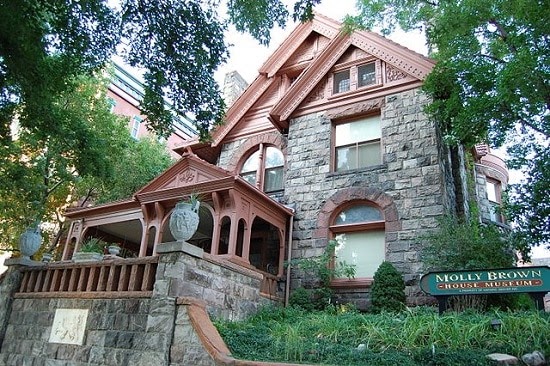 With its distinctive Queen Anne and Richardsonian Romanesque style, the ‘Molly Brown House’ is as remarkable as the woman who called it home for so many years.
With its distinctive Queen Anne and Richardsonian Romanesque style, the ‘Molly Brown House’ is as remarkable as the woman who called it home for so many years.Image: Molly Brown House by Onetwo1 at the English Wikipedia, CC BY-SA 3.0
After Molly’s death, the house was drastically changed to accommodate multiple tenants. The neighborhood declined throughout the 20th century, but the home was saved in the early 1970s by the efforts of preservationists and successful fundraising efforts due in part to the popularity of the musical and movie, The Unsinkable Molly Brown. In the years that followed, the home has been restored to its former splendor.
Molly Brown would be proud to welcome visitors into her home today, allowing them to learn more about what life was like in Denver during the Victorian era. You can also visit her birthplace home in Hannibal, MO.
Connecticut
The Glass House | New Canaan, CT
Year Built: 1949-1995
Architectural Style: Abstract Modern / International Style
Architect/Designer: Philip Johnson
Original Owner: Philip Johnson
Other Notable Owners: National Trust for Historic Preservation
The Glass House: Love It? Leave It?
Until 1949, most American homes looked relatively similar. Then The Glass House came along, ushering in a novel approach to residential architecture. The Glass House is perhaps one of the few homes in the world where you can see the sunset and moonrise at the same time. Those are the words of its architect Phillip Johnson, who lived in the home from 1949 until his death in 2005. The walls are made entirely of glass panes, which offer an unsurpassed 360-degree view!
Perched on a rocky hilltop in New Canaan, Connecticut, The Glass House blends seamlessly into the landscape and overlooks a tranquil pond. Every detail was meticulously planned, with minimalist furniture and rugs used to designate "rooms" in the 1,815-square-foot space. Artwork by renowned masters fills the interior. The herringbone brick floor provides warmth to the otherwise stark interior.
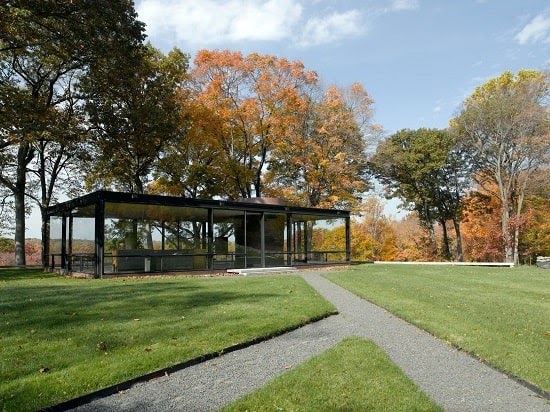 A bold design that ushered Modern architecture into the home, Philip Johnson’s Glass House in New Canaan, Connecticut has walls made only of — you guessed it — glass
A bold design that ushered Modern architecture into the home, Philip Johnson’s Glass House in New Canaan, Connecticut has walls made only of — you guessed it — glassImage: Carol M. Highsmith's America, public domain, Library of Congress, Prints and Photographs Division
Frank Lloyd Wright was no fan declaring on entering it for the first time he didn’t know whether “to take my hat off or leave it on.” However, so many architecture critics fell in love that its design reshaped the American Modern style.
Mark Twain House & Museum | Hartford, CT
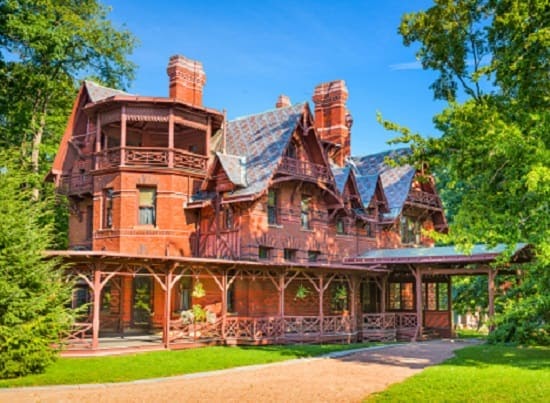 In Hartford, Connecticut, the Clemens family home is where so many of this author’s characters and books came to life. Yes, Mark Twain and his family spent their happiest years together in this Victorian Gothic mansion.
In Hartford, Connecticut, the Clemens family home is where so many of this author’s characters and books came to life. Yes, Mark Twain and his family spent their happiest years together in this Victorian Gothic mansion.Image: ID 66356341 © Sean Pavone | Dreamstime
Year Built: 1873-1874
Architectural Style: Victorian Gothic
Architect/Designer: Edward Tuckerman Potter
Original Owner: Sam and Olivia Clemens
Other Notable Owners: National Trust for Historic Preservation
Where Mark Twain Breathed Life into Tom Sawyer & Huck Finn
Some of the most famous literary characters came to life inside a Stick-Style mansion in the heart of Hartford, Connecticut. Sam Clemens — better known by his pseudonym, Mark Twain — spent his most productive years inside the house that he and his wife considered their dream home. Today, visitors from across the world come to walk through the halls where greatness was born.
While most tourists now refer to it as the Mark Twain House, the estate was known as the Hartford Home to the Clemens family. They commissioned architects to build their grand, magnificent house in 1873 and moved into the completed 11,500-square-foot mansion in 1874. The Clemens family lived there until 1891. Mark Twain himself said that he and his family spent their happiest years there.
Now a National Historic Landmark, the Mark Twain House is a treasured attraction in Hartford. Walking through the home, visitors can imagine him penning Adventures of Huckleberry Finn in the study and picture his wife Olivia hosting society events in the elegant ballroom. Interested in the life and times of Mark Twain? Then, this home is a must-see destination.
Sources/Resources:
Delaware
Nemours Estate | Wilmington, DE
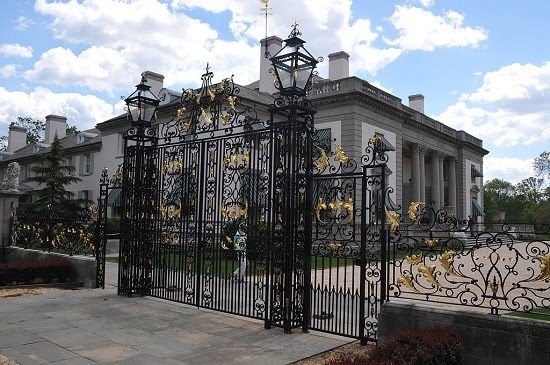 In the day, visitors would pass through the main gates to the motor court in front of the Nemours Mansion, an impressive example of French Neoclassical architecture right in Wilmington, Delaware.
In the day, visitors would pass through the main gates to the motor court in front of the Nemours Mansion, an impressive example of French Neoclassical architecture right in Wilmington, Delaware.Image:Nemours Mansion and Gardens by Jerrye & Roy Klotz MD, CC BY-SA 3.0
Year Built: 1909-1910
Architectural Style: French Neoclassical, Louis XVI Style
Architect/Designer: Carrère and Hastings
Original Owner: Alfred I. du Pont
Experience a Taste of France in the Heart of Delaware at Nemours Mansion
When you step onto the Nemours Estate and get your first glimpse of the mansion, you may have to blink once or twice, as it may feel like you’ve been transported to the heart of Europe. The Nemours Mansion was given to Alice du Pont as a gift from her husband, who enjoyed showering her with lavish displays of affection. Upon his death, though, du Pont’s will created the Nemours Mansion and Gardens “for the pleasure and benefit of the public.”
Designed in the French architectural style of the 18th century, the Nemours Mansion appears as if it has been part of the countryside for hundreds of years. However, it was built around the turn of the 20th century. While du Pont wanted to pay homage to his French heritage, he spared no expense when incorporating modern conveniences into the design.
Visitors who tour the 47,000 square foot home today will be able to walk through almost half of the 70 rooms, including the impressive Reception Hall, where a Peale painting of President George Washington still hangs on the wall. Unlike the historic chateaux of France, this mansion was built with the first elevator in the state of Delaware, a bowling alley, and a movie screen.
For many, a visit to the Nemours Mansion is an idyllic escape to the past, where they can celebrate the tradition of Europe and the modernity of America in one spot.
Florida
The Ernest Hemingway Home & Museum | Key West, FL
Year Built: 1849-1851
Architectural Style: Spanish Colonial
Architect/Designer: Asa Tift
Original Owner: Asa Tift
Other Notable Owners: Pauline & Ernest Hemingway (1931-61), Bernice Dixon & family (1961-present)
The Books, the Wives, the Lifestyle of “Papa” Hemingway in Key West
When "legend" is used to describe a person, it is a sure indication the individual will be remembered through the years. This is true of Nobel Prize-winning author Ernest Hemingway who made his home in Florida in 1931. Situated in ld Town Key West, the Hemingway Home, built in 1851, embodies charm and elegance while embracing Florida's abundance of brilliant sunshine, sandy shores, turquoise waters, and spectacular sunsets. The sub-tropical atmosphere served as an inspiration to the author, who penned some of his most notable books during his residence.
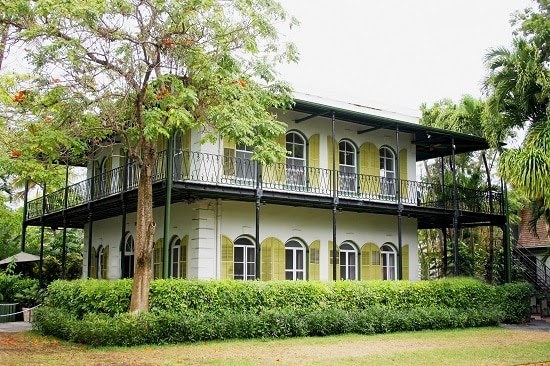 Enjoy the cool, tropical breezes from the balcony of what was once Ernest Hemingway’s home in Key West, Florida. The Spanish Colonial home is impressive and so are some of Hemingway’s little luxuries like the inground pool and his fishing boat.
Enjoy the cool, tropical breezes from the balcony of what was once Ernest Hemingway’s home in Key West, Florida. The Spanish Colonial home is impressive and so are some of Hemingway’s little luxuries like the inground pool and his fishing boat.Image: 57283568 © Marynag | Dreamstime
Take a guided tour of the home filled with original furniture and accessories, stroll the colorful and exotic flower and tree gardens, and reflect by the expansive in-ground saltwater swimming pool - an unheard-of luxury at that time. You will also meet dozens of polydactyl (six-toed) felines. Many are descendants of Ernest Hemingway's white cat companion named Snow White.
Sources/Resources:
Georgia
The Twelve Oaks | Covington, GA
Year Built: 1836
Architectural Style: Antebellum / Neoclassical
Architect/Designer: Unknown
Original Owner: John Harris
Other Notable Owners: Robert Franklin Wright, Nathaniel S. Turner
Step Into the Past of the Antebellum South at The Twelve Oaks
Fictitious Ashley Wilkes lived in the magnificent plantation home Twelve Oaks, and this plantation was brought to life in the iconic film "Gone With the Wind." While the film was shot in 1939, it still has a passionate, modern-day fan base who wants to experience the movie’s magic for themselves.
Fortunately, if you are one of those fans, you can step into The Twelve Oaks yourself when you visit Covington, Georgia. The mansion that served as inspiration for the movie's set still exists today and has been renamed to reflect its famous moment in the spotlight.
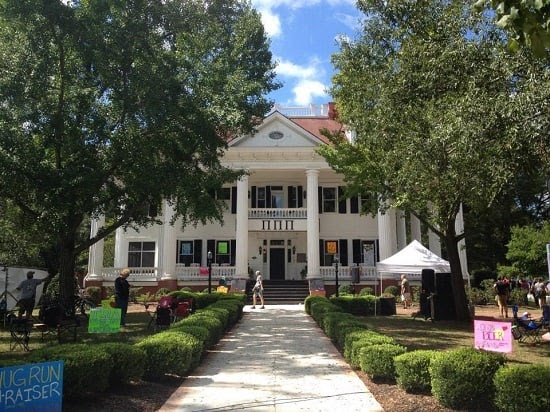 The iconic Antebellum style of Twelve Oaks in Covington, Georgia, lends itself as an ideal backdrop for everything from weddings to film productions.
The iconic Antebellum style of Twelve Oaks in Covington, Georgia, lends itself as an ideal backdrop for everything from weddings to film productions.Image: Twelve Oaks Vacation Movie Filming by Caligustafson, CC BY-SA 3.0
When you tour the home, you will not only find out more about the filming of the movie, but you will discover the role that this house played in the past. Built in 1836 by Judge John Harris, the home served as the in-town house for the plantation owner. After the Civil War, the house changed hands several times and underwent expansion. Today, this home-turned-bed-and-breakfast is the oldest mansion standing in the Atlanta area.
With its distinct, antebellum architectural style, Twelve Oaks has been featured in both film and TV, including Vacation, The Vampire Diaries, Halloween II, and Southern Fried Homicide. Whether seen in person or on the screen, The Twelve Oaks will grab your attention.
Hawaii
Liljestrand House | Honolulu, HI
Year Built: 1952
Architectural Style: Midcentury Modern / Hawaiian Modern
Architect/Designer: Vladimir Ossipoff
Original Owner: Betty & Howard Liljestrand
Other Notable Owners: The Liljestrand Foundation
The Liljestrand House: An Iconic Expression of Place
Set amidst the lush beauty of its Mount Tantalus location near Honolulu, the iconic mid-twentieth-century residence of Howard and Betty Liljestrand has changed little since the day it was finished. Originally intended as a "do-it-yourself" project that grew too complex for the couple, the home was completed in 1952 with the help of Russian-born, Japanese-raised architect Vladimir Ossipoff and landscape architect Catherine Thompson.
It represents a distinctive interplay of natural materials, functional beauty, and period design, integrated with spectacular views and a creative floor plan.
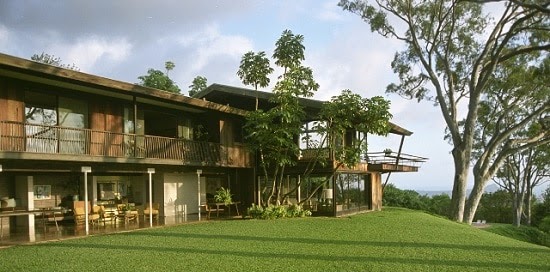 LIttle changed from when it was completed, Liljestrand House in Honolulu is a fine example of mid-twentieth-century modern Hawaiin architecture.
LIttle changed from when it was completed, Liljestrand House in Honolulu is a fine example of mid-twentieth-century modern Hawaiin architecture.Image: Liljestrand House - Makai Elevation by Bob Liljestrand, CC BY-SA 3.0
The couple's four children established the Liljestrand Foundation in 2007 to preserve the dwelling. Its excellent site on the mountain slope and "place-sensitive" architecture earned it a place on the National Register of Historic Places.
It is maintained today precisely as it was then, with all its original furnishings, and is available for tours, special events, conferences, and educational programs. Maintenance and preservation efforts are ongoing.
Sources/Resources:
Iowa
American Gothic House & Center | Eldon, IA
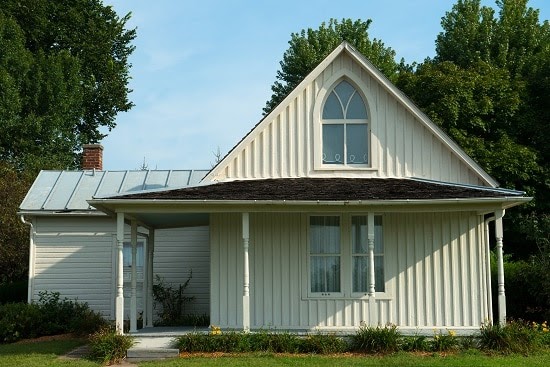 Considered part of American pop culture today, the painting American Gothic by Grant Wood was inspired by this Carpenter Gothic style home in Eldon, Iowa.
Considered part of American pop culture today, the painting American Gothic by Grant Wood was inspired by this Carpenter Gothic style home in Eldon, Iowa.Image: 107251183 © Wisconsinart | Dreamstime
Year Built: 1881-1882
Architectural Style: Carpenter Gothic
Architect/Designer: Busey & Herald
Original Owner: Catherine and Charles Dibble
Other Notable Owners: Carl E. Smith, State of Iowa
Grab Your Pitchfork and Visit the American Gothic House
The American Gothic painting by Grant Wood is considered one of the most famous American paintings of the modern era. It is known as a symbol of Midwestern strength, stability, and resilience during the Great Depression. While people of all ages recognize the painting itself, most do not realize it was the simple, cottage-like farmhouse with its Carpenter Gothic style in the background that inspired the work as a whole.
To better understand this pivotal piece of American popular culture, you can visit the American Gothic House and Center in Eldon, Iowa. There, you will find the white-washed farmhouse with its Gothic window taking center stage.
It would be easy to simply pass by this rural farmhouse in the heart of the Midwest, but fortunately, Grant Wood did not. When you visit, you will see why he was inspired to create a painting in which the people in the foreground were as sturdy as the farmhouse behind them.
When we all need to rely on extra strength and perseverance, a trip to the American Gothic House and Center will remind you that people will continue to power on.
Kentucky
Conrad-Caldwell House | Louisville, KY
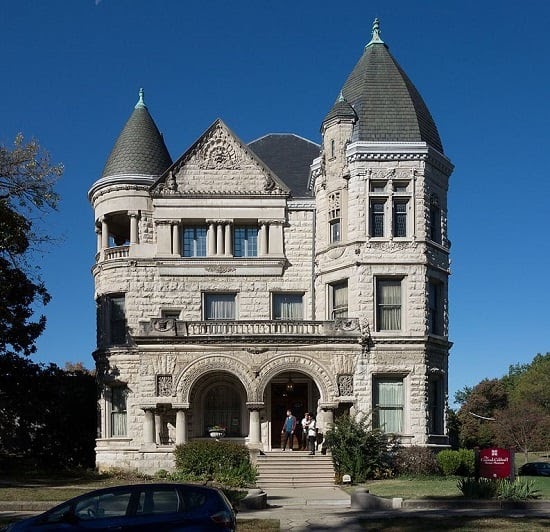 With an impressive exterior and an interior to match, the Conrad-Caldwell House in Louisville, Kentucky, is considered one of the best examples of Richardsonian Romanesque architecture.
With an impressive exterior and an interior to match, the Conrad-Caldwell House in Louisville, Kentucky, is considered one of the best examples of Richardsonian Romanesque architecture.Image:Kenneth C. Zirkel, CC BY-SA 4.0
Year Built: 1895
Architectural Style: Richardsonian Romanesque; Late Victorian
Architect/Designer: Arthur Loomis
Original Owner: Mary and Theophile Conrad
Other Notable Owners: William E. Caldwell
You’re Invited to Conrad-Caldwell House, Kentucky's Finest Castle
Kentucky is not the type of place where one would expect to run into a castle, but Louisville is a city full of surprises. Visitors to the area love exploring the Conrad-Caldwell House, which is considered one of the best examples of Richardsonian Romanesque architecture.
Built during the twilight years of the 19th century, the Conrad-Caldwell House was designed to reflect all of the elegance and opulence of the Gilded Age. However, compared to its counterparts across the ocean in Europe, this home was designed with American modernity in mind. It had indoor plumbing as well as every imaginable convenience available during that period.
The breathtaking home was a private residence for nearly 50 years, then changed hands several times until it was purchased by a committed group of neighbors who wanted to preserve it. Today, the castle is a museum that highlights the beauty and grandeur of the Victorian Age in Louisville.
Those who tour this home will not only learn about the occupants who lived in it, but also the history of Old Louisville itself. It's the perfect way to take a step back in time and experience what life would have been like for local socialites and prominent people in business.
Massachusetts
The Paper House | Rockport, MA
Year Built: 1922-1924
Architectural Style: Cabin / “Newspaper”
Architect/Designer: Elis F. Stenman
Original Owner: Elis F. Stenman
Other Notable Owners: Edna Beaudoin
Discover the Secrets of The Paper House
Everyone knows you can make a house from sticks and stones, but what about a house made entirely of paper? It sounds impossible and perhaps a bit (absurd or ridiculous?), but Elis F. Stenman defied the odds and made his dream come true. What began as a hobby in 1922 transformed into a life's commitment to creating a home — and all of its furniture — entirely out of newspaper.
Billed as "One of the Most Unique Sites You Will Ever See," The Paper House is situated just north of Boston in the idyllic community of Rockport, Massachusetts.
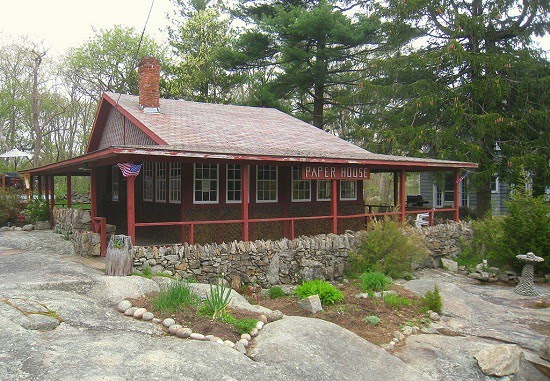 Begun as a hobby in 1922 by Elis Stenman, this cabin-like structure looks similar to many cabins. However, upon closer inspection, you will see it is built from newspapers. Step inside, and you will find that even the furniture is made from newspapers!
Begun as a hobby in 1922 by Elis Stenman, this cabin-like structure looks similar to many cabins. However, upon closer inspection, you will see it is built from newspapers. Step inside, and you will find that even the furniture is made from newspapers!Image: Daderot, public domain, Wikimedia Commons
From afar, it appears to be a historic cottage, the likes of which could be found in any New England town. When you take a closer look, however, you can read the old headlines and see that the house is, in fact, made of paper.
If you step inside the home, you’ll quickly discover that the exterior is not the only thing made from paper. Much of the furniture inside the house is also made of paper and still stands today. This includes a working piano as well as a desk and chair set. Seeing is believing at this iconic home — there is simply no other place like it in the world.
Minnesota
Glensheen | Duluth, MN
Year Built: 1905-1908
Architectural Style: Jacobean Revival
Architect/Designer: Clarence H. Johnston
Original Owner: Clara and Chester Congdon
Other Notable Owners: University of Minnesota
Uncover Authenticity at Glensheen Mansion in Minnesota
History has been preserved through the ages, but it’s often viewed through a filter placed upon it by modern interpreters. However, those who want to experience authenticity at its finest have the opportunity to do so at Glensheen Mansion in Duluth, Minnesota.
Built at the turn of the 20th century, Glensheen is a Jacobean mansion named and modeled after an ancestral home in England. Commissioned by the influential Congdon family, the Congdons lovingly preserved the house during the many years they resided there.
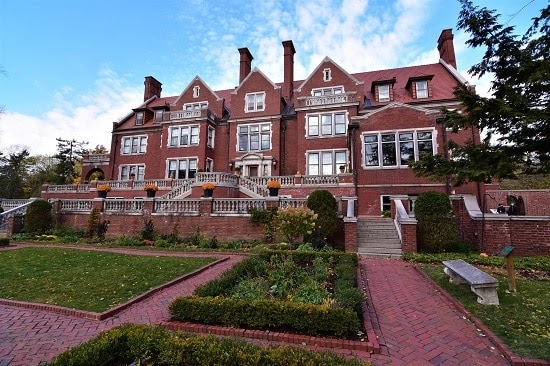 At 20,000 square feet and looking out over Lake Superior, Glensheen is a sight to behold. Built in Jacobean Revival style, the mansion’s interior has been carefully preserved. Outside, the 22 acres encompass formal English gardens and natural paths through the woods.
At 20,000 square feet and looking out over Lake Superior, Glensheen is a sight to behold. Built in Jacobean Revival style, the mansion’s interior has been carefully preserved. Outside, the 22 acres encompass formal English gardens and natural paths through the woods.Image: 199720449 © Adam Wineke | Dreamstime
Upon donating the estate to the University of Minnesota in 1979, preservationists realized its entire collection within the home was original and authentic. There were top hats in closets that belonged to the family patriarch, Chester Congdon. There were original stationery and preserved copies of letters in the desk drawers. History reveals itself in its true form, and it is now available for anyone wanting to experience it for themselves.
Glensheen and its surrounding gardens are open to the public for tours. If you want to discover what 20th-century life was like for one of the most powerful families in Minnesota, then a visit to this mansion is undoubtedly in order.
Mississippi
Elvis Presley’s Birthplace | Tupelo, MS
Year Built: 1934
Architectural Style: Shotgun Style House
Architect/Designer: Vernon Presley
Original Owner: Gladys and Vernon Presley
Other Notable Owners: City of Tupelo
Visit the Humble Beginnings of the King of Rock and Roll at Elvis Birthplace
In the final years of his adult life, Elvis Presley was able to leave his blue suede shoes at the front door of his Graceland mansion. But his beginnings were much more humble, and his most devoted fans have the opportunity to visit his birthplace.
The two-room home where Elvis Presley was born has been preserved and is open to the public for tours. Located in Tupelo, Mississippi, this simple home was built by his father, grandfather, and uncle. When you walk up to the house, it's easy to imagine Elvis' mother loving her baby tenderly as she rocked him on the front porch.
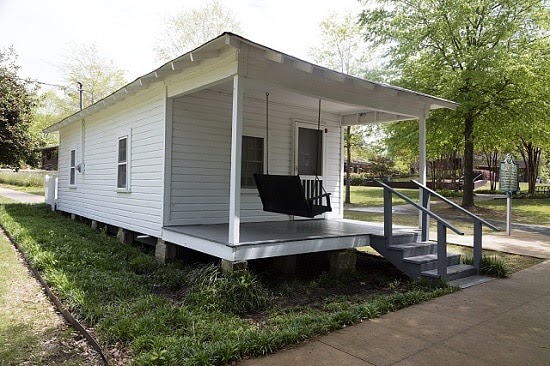 The “King of Rock and Roll,” Elvis Aron Presley was born in this two-room shotgun-style house his father had built.
The “King of Rock and Roll,” Elvis Aron Presley was born in this two-room shotgun-style house his father had built.Image:Photographs in the Carol M. Highsmith Archive, public domain, Library of Congress, Prints and Photographs Division
In addition to exploring this quaint home, you also have the opportunity to tour the Assembly of God Church. The church has been moved from its original location to the birthplace of Elvis, allowing more people to discover what the earliest years of life were like for the King.
Well before tunes like "Jailhouse Rock" and "Heartbreak Hotel" were on the hearts and minds of every American, Elvis was just a simple Southern boy growing up in a small town. Now, you have the opportunity to see what life was like from his perspective.
Montana
C.M. Russell House & Studio | Great Falls, MT
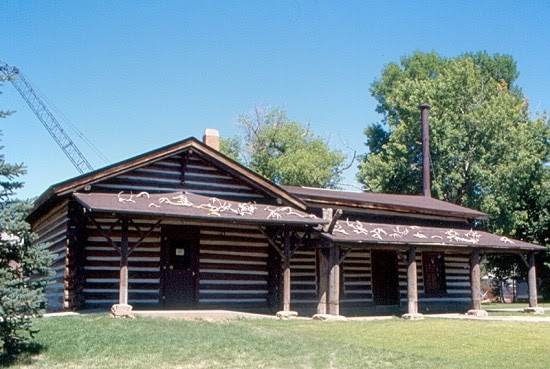 A painter of the American West during the late 19th and early 20th centuries, including cowboys, Native Americans, and landscapes, Charles M. Russell, built this cabin in Great Falls, Montana as his studio.
A painter of the American West during the late 19th and early 20th centuries, including cowboys, Native Americans, and landscapes, Charles M. Russell, built this cabin in Great Falls, Montana as his studio.Image: Roger Wollstadt, CC BY-SA 2.0
Year Built: 1900 (house), 1903 (log cabin studio)
Architectural Style: Arts & Crafts (house), Vernacular (log cabin)
Architect/Designer: George Calvert (house), Charles M. Russell (log cabin)
Original Owner: Nancy and Charles M. Russell
Other Notable Owners: Trigg-C.M. Russell Foundation
Step Inside the American West at Charles Marion Russell's Log Studio
When most Americans think of the Wild West, images of bucking broncos, steadfast cowboys and stoic Native Americans often come to mind. They imagine these scenes largely due to the work and influence of Charles Marion Russell, an artist who specialized in colorful, sweeping paintings of the American West during the late 19th and early 20th centuries.
Those who want to immerse themselves in the life and works of Charles Marion Russell can visit the C.M. Russell Museum in Great Falls, Montana. Visitors to the museum will be able to discover the many different collections that the artist completed over the years and walk through his home and personal studio. It is his log art studio, built of red cedar telephone poles, that brings you back to the time when the American West was still a frontier country.
For more than 60 years, this museum has been welcoming people of all ages. Its mission is to teach visitors more about the life and work of Charles Marion Russell through an engaging and captivating experience. If you want to feel as if you’ve stepped into one of the panoramic landscapes he painted or into a ferocious Western fight, then add this to your list of places to visit in Montana!
Nevada
Thunderbird Lodge | Lake Tahoe, NV
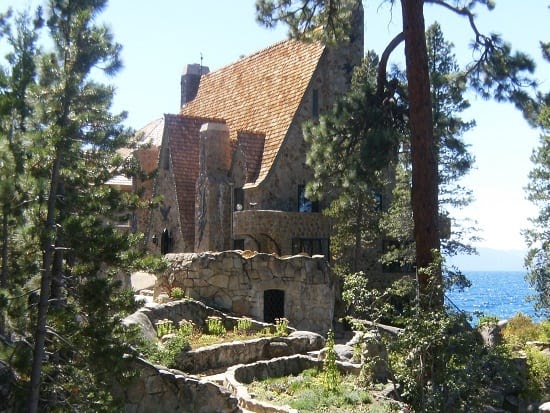 Designed by Frederick DeLongchamps for George Whittell Jr., Thunderbird Lodge enjoys commanding views of Lake Tahoe in Nevada.
Designed by Frederick DeLongchamps for George Whittell Jr., Thunderbird Lodge enjoys commanding views of Lake Tahoe in Nevada.Image:Ronda Kingsford, public domain, U.S. National Archives
Year Built: 1936
Architectural Style: Rustic, Tudor Revival
Architect/Designer: Frederick DeLongchamps
Original Owner: George Whittell, Jr.
Other Notable Owners: Jack Dreyfus, Thunderbird Preservation Society
Experience the “Captain’s” Wild Coastline of Lake Tahoe at Thunderbird Lodge
From the water, the Thunderbird Lodge is a majestic, breathtaking mansion sitting at the edge of Lake Tahoe. It instantly sparks questions from those seeing it for the first time. They want to know who built this home, who had the privilege of living in it, and how one step inside its hallowed walls?
Born into one of California’s wealthiest families, George Whittell Jr., also known as the “Captain,” probably never imagined that his home would one day become a popular tourist attraction. He would likely be proud of the number of people who gaze at his property in complete and total awe each year. As one of the richest, more eccentric, and more reclusive men on the West Coast, Whittell was able to construct the impressive estate during the depths of the Great Depression. The lodge consists of several different structures “built to blend harmoniously with its surroundings.”
Each building consists of its own eye-catching architectural elements and unusual features, including a 600-foot long tunnel, blasted through granite from the main house to the boathouse. Having “run away” as a young man to join the circus, his love of animals motivated him to collect exotic pets at Thunderbird, including an African lion and an elephant. The Captain lived on the property until 1957 and owned it until his death in 1969.
Since then, the property has been purchased several times and most of the land has been sold to the U.S. Forest Service and Nevada State Parks. Whittell is credited with preserving the shoreline of Lake Tahoe — even if his intention was never quite so pure.
To experience man-made marvels and the beauty of the natural world in one idyllic location, stop by Thunderbird Lodge.
New Hampshire
The Robert Frost Farm | Derry, NH
Year Built: 1884
Architectural Style: Farmhouse
Architect/Designer: Nathaniel G. Head
Original Owner: Nathaniel G. Head
Other Notable Owners: Elinor and Robert Frost
Take the Road Less Traveled at the Robert Frost Farm
A simple white farmhouse and the land surrounding it was the source of infinite inspiration for acclaimed American poet Robert Frost. Located in Derry, New Hampshire, the Robert Frost Farm is now a historic landmark open to visitors who wish to tour it.
Robert Frost lived in this home with his family from 1900 until 1911. As his career as a poet grew and evolved in the years following his stay in Derry, he attributed many of his works to his precious memories from his time spent there. Today, visitors come from around the world to walk in his footsteps and discover for themselves why he was inclined to put those powerful words down on paper.
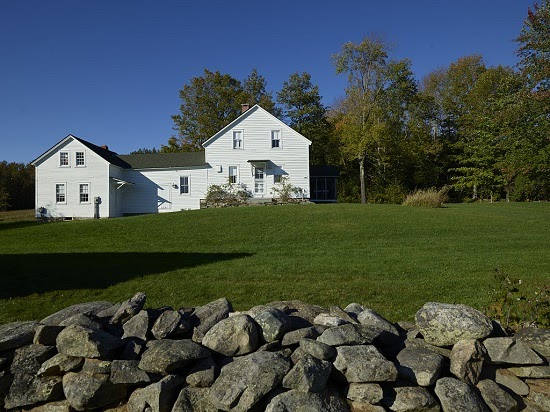 Robert Frost and his family lived in this farmhouse in Derry, New Hampshire, from 1900 to 1911.
Robert Frost and his family lived in this farmhouse in Derry, New Hampshire, from 1900 to 1911.Image: Carol M. Highsmith Archive, public domain, Library of Congress, Prints and Photographs Division
In addition to enjoying a self-guided tour of the home, you also will have the opportunity to wander along a story trail that winds through the property that surrounds the house. You may not see the road diverging right before your eyes, but when you visit the Robert Frost Farm, you will understand why he was captivated by the essence of New England.
New Jersey
Lucy the Elephant | Margate, NJ
Year Built: 1881
Architectural Style: Novelty
Architect/Designer: James Lafferty
Original Owner: James Lafferty
Other Notable Owners: Anton Gertzen, Save Lucy Committee
Visit Lucy the Elephant, the Original Roadside Attraction
The quintessential American road trip has to include a stop or two at roadside attractions. From larger-than-life teapots to looming dinosaurs, it seems there is always something new to discover along the highways that wind throughout the United States. However, none are quite as famous as Lucy the Elephant.
Larger than life, Lucy the Elephant stands more than six stories tall and is located along the coast of New Jersey. Constructed in 1881, Lucy was built by a real estate developer as a gimmick to attract buyers and is the nation's oldest surviving roadside attraction. While it has been moved from its original location and undergone significant restoration efforts, Lucy still stands tall and proud as one of the state’s most iconic sites.
Over the course of its lifetime, this roadside attraction was a restaurant, a tavern, and even a cottage. Today, people love to stop by Lucy and have their photograph taken with this six-story tall elephant, which is also a National Historic Landmark. However, beginning in 2020, Lucy has taken on a new life. You can now book a stay through Airbnb and stay overnight in this infamous elephant.
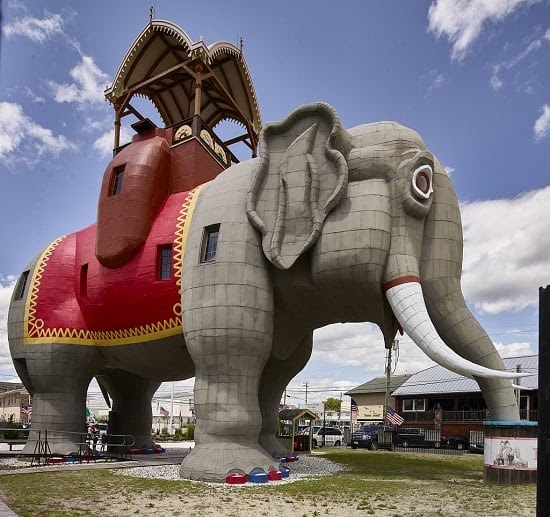 Perhaps America’s first roadside attraction, Lucy the Elephant, was built in 1881 by James Lafferty to promote his real estate development in Margate, New Jersey.
Perhaps America’s first roadside attraction, Lucy the Elephant, was built in 1881 by James Lafferty to promote his real estate development in Margate, New Jersey. Image: Carol M. Highsmith Archive, public domain, Library of Congress, Prints and Photographs Division
Rather than taking a quick selfie with Lucy, seize the moment and spend some additional time with her. You won't regret experiencing this historic roadside attraction for yourself!
Sources/Resources:
New Mexico
Earthship Global | Taos, NM
Year Built: 1970s
Architectural Style: Sustainable Design with Natural and Upcycled Materials
Architect/Designer: Michael Reynolds
Original Owner: Multiple owners
Earthship Global: Self-Sufficient and Off-the-Grid Homes
Although it sounds right out of a 1950s space movie, these amazing homes, primarily located in Taos, New Mexico, seek to rely on Mother Nature to offer a self-sustaining structure. Made mainly out of natural & recycled materials, these Earthships, designed by Michael Reynolds, offer a way to coexist with nature.
The homes use passive solar heating and cooling. They also have a natural water recapture system for different elements of the home without the need for municipal water hookups or well water.
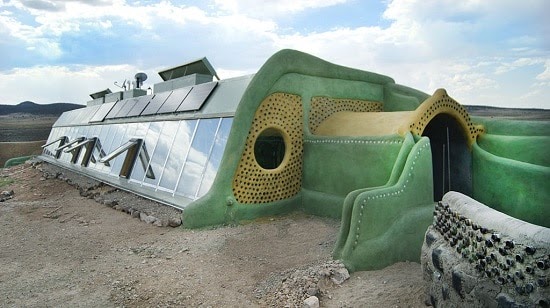 This model of the Earthship Global home, highlighting sustainable design using recycled and upcycled materials, is in Taos, New Mexico.
This model of the Earthship Global home, highlighting sustainable design using recycled and upcycled materials, is in Taos, New Mexico.Image:Biodiesel33, CC BY-SA 3.0
The water is cleaned through botanical cells, while these plants also produce organic food inside the house. Imagine no grocery stores for food and no utility bills. Now, if they could only get my kids to clean and do laundry. A girl can dream, can’t she?
If you’re not sure how you feel about living off the grid, Earthship Global offers tours daily. Still not convinced? Spend a night or two in an Earthship Global vessel at their main headquarters in Taos. If you’re ready to pack your bags, check out how to build your own home through an Earthship academy and internship program.
Sources/Resources:
Georgia O'Keeffe Home & Studio | Abiquiú, NM
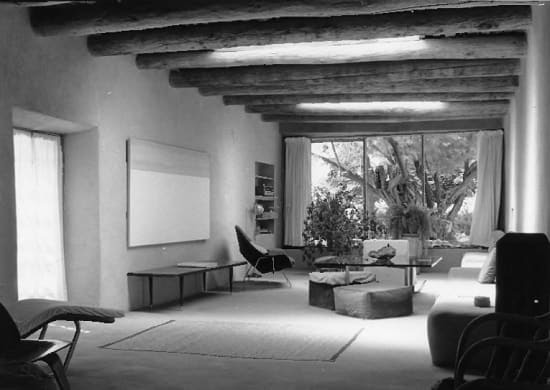 American painter Georgia O’Keeffe built her home and studio in Native American and Spanish Colonial styles in Abiquiú, New Mexico.
American painter Georgia O’Keeffe built her home and studio in Native American and Spanish Colonial styles in Abiquiú, New Mexico. Image:National Park Service, Public domain
Year Built: Earliest parts from 1730s but significantly expanded in 1940s
Architectural Style: Native American and Spanish Colonial
Architect/Designer: Georgia O'Keeffe (expansion)
Original Owner: Unknown
Other Notable Owners: Georgia O'Keeffe
See the World Through the Eyes of Georgia O'Keeffe
The works of modern American artist Georgia O'Keeffe are so inspiring, they can lead people to wonder what it might have been like to see the world through her eyes. What drove her to paint such amplified close-ups of floral blooms? What about the skulls set above dramatic, desert landscapes? Fortunately, you can try to get inside her thoughts when you visit the Georgia O'Keeffe Museum in Sante Fe, New Mexico.
The Georgia O'Keeffe Museum is located on the property that she once owned and lived on. Her historic adobe home was also her studio, and people from all over the world have found that it's an awe-inspiring place to explore. When you embark on the home tour, you can look through the same patio door that Georgia herself looked through and painted more than 20 different times.
Of course, outside the walls of the home are the trees, flowers, and landscapes that were the subject of many of her paintings. When you visit this museum, you will be impressed by the immersive experience. Few museums allow you to walk through the setting that inspired the artist before viewing the artist's most famous works in the gallery nearby. There's no better way to see the American West than through the eyes of one of the country's most beloved artists.
Sources/Resources:
New York
Carrie Bradshaw’s Brownstone | New York, NY
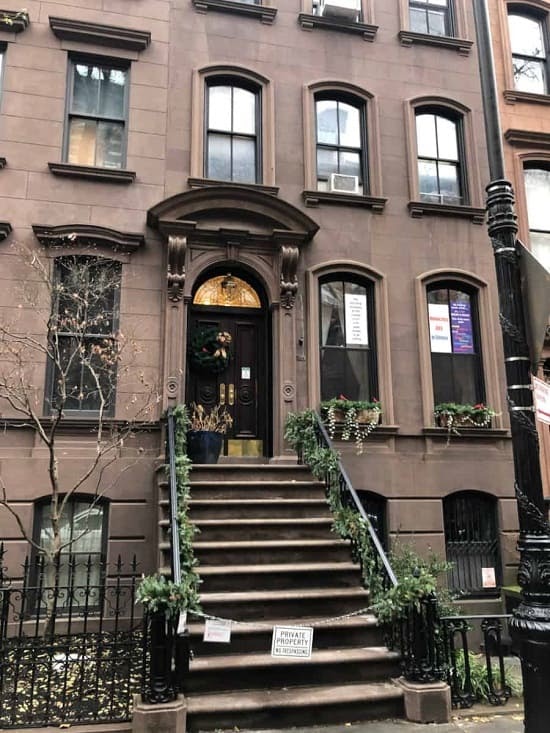 While Carrie Bradshaw from “Sex and the City” called the Upper West Side of Manhattan her home, her brownstone for filming purposes was located in Greenwich Village
While Carrie Bradshaw from “Sex and the City” called the Upper West Side of Manhattan her home, her brownstone for filming purposes was located in Greenwich VillageImage:The Plan Collection
Year Built: 1866
Architectural Style: Italianate
Architect/Designer: Robert Mook
Original Owner: Unknown
Pose in Front of the Steps of Carrie Bradshaw's Brownstone
Perhaps Carrie Bradshaw said it best when she said, "In New York, you're always looking for a job, an apartment, or a boyfriend." Fortunately, the witty, shoes-loving columnist always had a fantastic apartment, and luckily for you, you can see it for yourself.
While Carrie famously lived in the Upper East Side in the show, the house used for her apartment was a brownstone building built in the 1860s, located in the West Village. It is almost instantly recognizable by any super fan of “Sex and the City” because its stoop is where Carrie could often be found sitting and musing about life in the Big Apple.
Many people are surprised to find out that this iconic brownstone was actually the fourth building used for Carrie's home as part of the show's set. Tourists also often mistakenly believe that it is located at 64 Perry Street. Fortunately, those who want to experience the real deal can see it with On Location Tours.
In the words of Carrie herself, "I miss New York. Take me home." Head home to Carrie's place today!
To experience man-made marvels and the beauty of the natural world in one idyllic location, stop by Thunderbird Lodge.
Sources/Resources:
Manitoga | Garrison, NY
Year Built: 1941-1961
Architectural Style: Modernist/Modern
Architect/Designer: David Leavitt and Russel Wright
Original Owner: Russel Wright
Explore Manitoga: Where Modernity Meets Nature
Not everything is quite as it seems at Manitoga. The estate of industrial designer Russel Wright looks tucked away in a sea of trees, overlooking a quaint pond. Its panoramic windows allow anyone inside to feel as if they are completely one with nature. However, this modernist house, which is now considered a National Historic Landmark in New York, sits on ground that was once a rock quarry.
When Wright arrived on-site in the 1960s, he envisioned creating an estate and woodland garden that would allow him to escape the confines of the inside world and immerse himself in the great outdoors. He worked with architect David Leavitt to create the home of his dreams. Most significantly, Wright left nothing to chance, creating an environment that harmonized the organic with the inorganic
Fortunately, Wright left it for all to enjoy. Today, visitors can tour Manitoga (also known as The Russel Wright Design Center) to experience the house for themselves and learn more about the life and times of Wright. In addition, people are invited to hike winding trails around the wooded property.
Visiting Manitoga once is never enough. Every time you come back, you will experience the home and its beautiful surroundings in a new way.
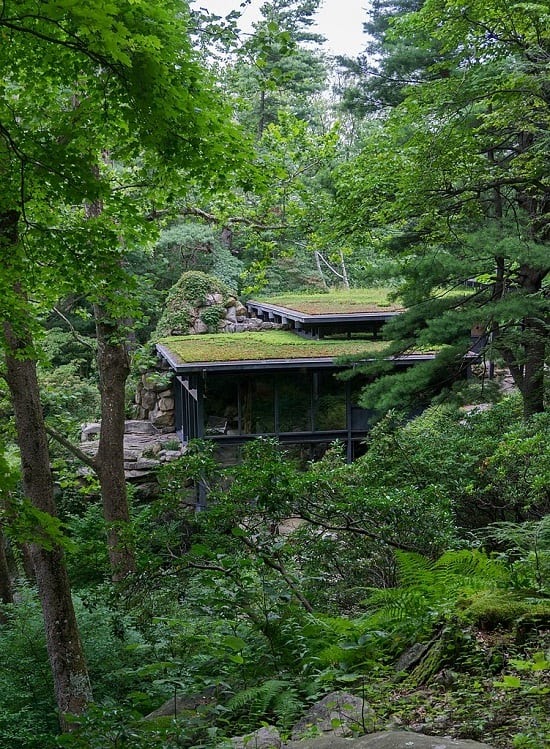 Designed by David Leavitt and Russel Wright, Manitoga achieves what few residences do - a home that is seemingly one with nature and its surroundings.
Designed by David Leavitt and Russel Wright, Manitoga achieves what few residences do - a home that is seemingly one with nature and its surroundings. Image: MJ, CC BY-SA 4.0
North Carolina
The Biltmore Estate | Asheville, NC
Year Built: 1889-1895
Architectural Style: Chateauesque, French Renaissance
Architect/Designer: Richard Morris Hunt
Original Owner: George Vanderbilt
Other Notable Owners: Edith Vanderbilt, Cornelia Cecil, and descendants
Biltmore: Gilded Age in the Blue Ridge Mountains
This tree-filled, somewhat off-the-beaten-path location of Asheville, North Carolina, in the heart of America's Blue Ridge Mountains may seem an unlikely area for the historic estate that boasts the nation's largest house. George Vanderbilt, the grandson of legendary entrepreneur and tycoon Cornelius Vanderbilt, built the sprawling estate as a family retreat more than a century ago. Today, the residence remains much like it did, with gorgeous surrounding gardens open for self-guided tours.
Touring Biltmore House, the main residence, offers a window into a lifestyle that few can imagine. Built during the Gilded Age, the Chateauesque-style mansion boasts over 178,000 square feet of floor space and 250 rooms, including 35 bedrooms. The principal rooms are grand in both size and historical architectural detail. However, Biltmore also included plenty of innovations for a 19th-century house, such as an Otis elevator, forced air heating, and fire alarms.
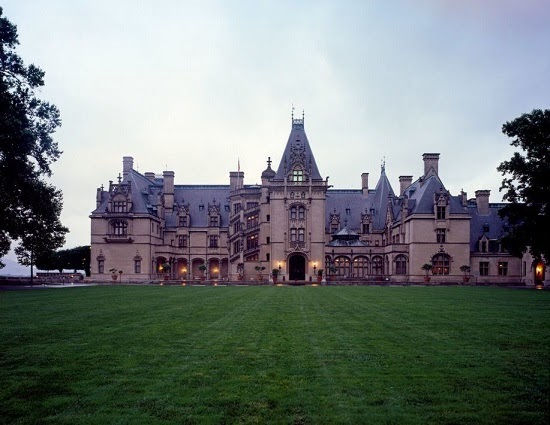 With 250 rooms, the chateau-inspired Biltmore Estate was designed by Richard Morris Hunt for George Vanderbilt in the late 19th century.
With 250 rooms, the chateau-inspired Biltmore Estate was designed by Richard Morris Hunt for George Vanderbilt in the late 19th century.Image:Carol M. Highsmith Archive, public domain, Library of Congress, Prints and Photographs Division
Spending a night at the Biltmore Estate, with accommodations at one of three distinctive properties, is an entirely different and delightful experience, one that makes clear why Vanderbilt picked this location. Explore the grounds and gardens, the adjacent winery, hiking and biking trails, and modern Asheville with its shops, eateries, breweries, musicians, and other attractions.
Ohio
“A Christmas Story” House | Cleveland, OH
Year Built: 1895
Architectural Style: Victorian, Colonial
Architect/Designer: Unknown
Original Owner: Unknown
Other Notable Owners: Brian Jones
Spend the Night at A Christmas Story House
“I triple dog dare ya!” From the exterior, the home is an iconic, painted Midwestern two-story with a pitched roof, a front porch, and a fenced yard. But for anyone who loves watching A Christmas Story and the antics of Ralphie, his friends, and Old Man Parker, visiting this home represents a return to simpler times and the well-remembered emotions of growing up as a kid and the holidays.
The home, which has been completely restored to reflect how it appeared in the film down to the Christmas tree in the living room corner, is located on a quiet street in Cleveland, Ohio. Open for tours throughout the year, it is now also available for overnight stays. A museum featuring original props and costumes, as well as additional memorabilia, is just across the street. Just be careful, as some of it is “Fra-Gee-Lay!”
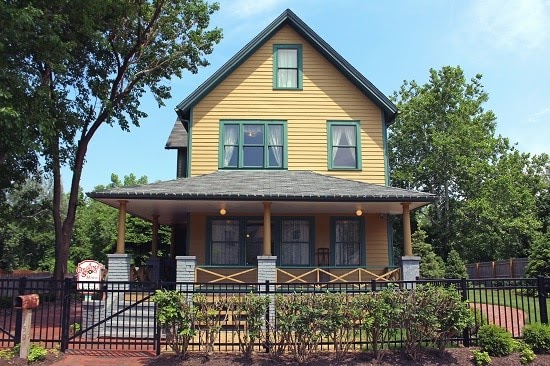 While the Parker family from “A Christmas Story” lived in Indiana, the shooting location was at this home in Cleveland, Ohio
While the Parker family from “A Christmas Story” lived in Indiana, the shooting location was at this home in Cleveland, OhioImage:Jason Miller/AP Images for A Christmas Story House and Museum; courtesy of A Christmas Story House
An extensive collection of photographs from the filming production is on display, along with reproductions and other gift items — including the “it’s a Major Award!” Leg Lamp — available for purchase. You can also visit the Bumpus House next door (https://www.achristmasstoryhouse.com/bumpus-house/)! Proceeds support ongoing maintenance and upkeep of the house. Visit the website for additional information and to book reservations for tours and stays.
Sources/Resources:
Pennsylvania
Fallingwater | Mill Run, PA
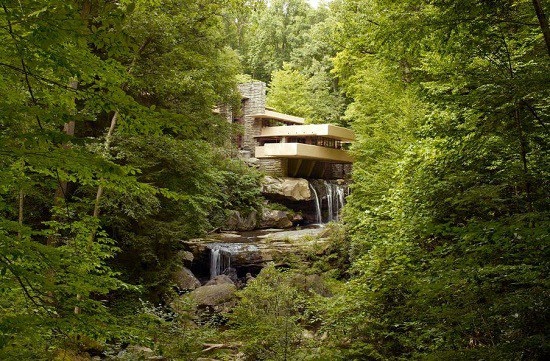 Designed by American architect Frank Lloyd Wright in 1935, Fallingwater in Mill Run, Pennsylvania is considered a modern and organic architecture masterpiece.
Designed by American architect Frank Lloyd Wright in 1935, Fallingwater in Mill Run, Pennsylvania is considered a modern and organic architecture masterpiece.Image:Carol M. Highsmith's America, Library of Congress, Prints and Photographs Division
Year Built: 1935 (designed), 1936-1937 (constructed)
Architectural Style: Modern, Organic
Architect/Designer: Frank Lloyd Wright
Original Owner: Edgar J. Kaufmann, Sr. & family
Other Notable Owners: Western Pennsylvania Conservancy
Come to Fallingwater, Where Nature and Architecture Combine
In an ever-connected modern world, more people are searching for places where nature and contemporary convenience blend perfectly together. Fortunately, those looking for peaceful solace and present-day comfort will love exploring Fallingwater.
Fallingwater is perhaps Frank Lloyd Wright's most iconic architectural feat. This masterpiece home was built in the 1930s for a Pittsburgh department store owner, but today it’s a public museum situated on protected and preserved land in Pennsylvania.
Upon first glance, Fallingwater appears to grow right out of the forest that surrounds it. Built using reinforced concrete, steel, stone masonry, and glass, the house rests on top of a cascading waterfall, which adds a sense of natural ambiance to the entire living space. Visitors enjoy exploring the home and taking in its distinct architectural features and have an opportunity to explore the extensive trails surrounding the property.
If you’re interested in the works of Frank Lloyd Wright, you won’t want to miss out on an opportunity to tour Fallingwater. It’s one of the only homes designed by Wright that contains its original furnishings, including nearly 170 built-in and freestanding items designed by Wright himself. A visit allows you to truly experience his commitment to organic architecture.
Wharton Esherick Museum | Malvern, PA
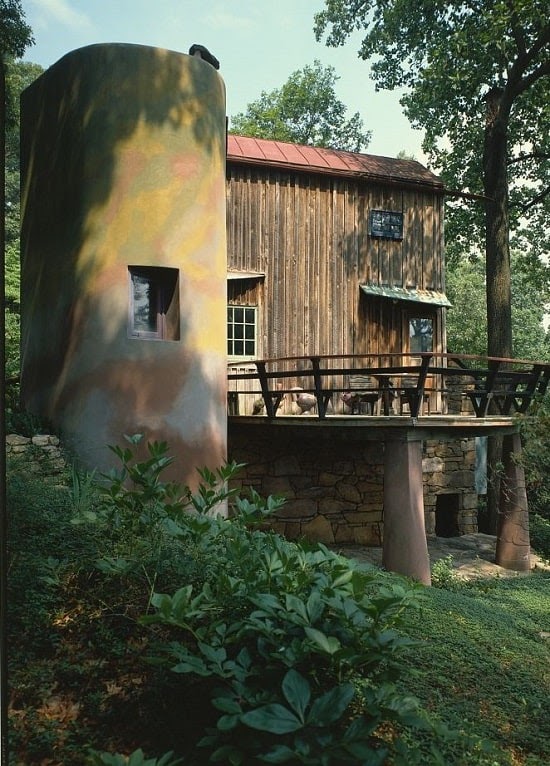 American woodworking artist Wharton Esherick built his studio in Malvern, Pennsylvania.
American woodworking artist Wharton Esherick built his studio in Malvern, Pennsylvania.Image:Historic American Buildings Survey (creator), Virginia B. Price (transmitter), public domain, Library of Congress
Year Built: 1926-1976
Architectural Style: Arts & Crafts, Expressionist, Organic
Architect/Designer: Wharton Esherick
Original Owner: Wharton Esherick
Discover the Wharton Esherick Museum - Where Art, Craftsmanship & Fun Combine
“If it’s not fun, it’s not worth doing,” American woodworking artist Wharton Esherick said frequently. He specialized in distinct wooden sculptures that he then incorporated into furniture and buildings. Esherick’s unrepeatable style is evident throughout his home and studio at the Wharton Esherick Museum.
The museum, located in Malvern, Pennsylvania, is an extensive campus that includes Esherick's hand-built studio, his Expressionist garage, and a historic schoolhouse that once served as his workspace during his early years as an artist. Situated across 12 acres of land, each building in the museum complex showcases the individual style of Esherick, highlighting the Arts and Crafts, Expressionist, and organic design styles that influenced him the most.
Today, visitors can explore the grounds and experience the artist's home and studio, which have both been preserved to showcase what it looked like when he lived and worked there. In addition, they can reflect upon the 300 different works of art on display throughout each building.
There’s no better way to uncover the secrets of an artist than by visiting his or her home and studio. The Wharton Esherick Museum is a piece of American culture and an important historic landmark to experience for yourself.
Sources/Resources:
Rhode Island
The Breakers | Newport, RI
Year Built: 1893-1895
Architectural Style: Neo-Italian Renaissance
Architect/Designer: Richard Morris Hunt
Original Owner: Cornelius Vanderbilt II
Other Notable Owners:Gladys Vanderbilt, The Preservation Society of Newport County
Vacation Like the Vanderbilts at The Breakers in Newport
Anybody who was anybody in society during America's glittering Gilded Age had a cottage in Newport, Rhode Island. The term “cottage” is a bit misleading, though, as most of these homes were more like mansions akin to grand European ancestral homes than quaint oceanfront cottages in the United States. The most magnificent of all of these majestic estates is The Breakers, the Vanderbilt family’s summer home.
When the Vanderbilt family purchased The Breakers, it was a wood-frame home on a premier lot in Newport. Cornelius Vanderbilt II quickly put his mark on the house by commissioning an architect to redesign it as a 16th-century Renaissance-style palazzo with plenty of Italian influence. In less than two years, the home was transformed into a palatial residence that included 70 rooms — all of which were fit for royalty and emanated American ingenuity. In fact, some rooms were built in Europe, shipped to the United States, and reassembled in Newport.
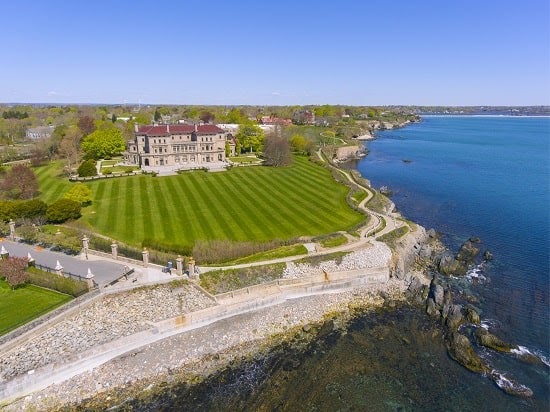 Built as the summer ‘cottage’ for the Cornelius Vanderbilt II family, The Breakers in Newport, Rhode Island, is a Neo-Italian Renaissance mansion.
Built as the summer ‘cottage’ for the Cornelius Vanderbilt II family, The Breakers in Newport, Rhode Island, is a Neo-Italian Renaissance mansion.Image: 184016058 © Jiawangkun | Dreamstime
Today, The Breakers still stands out as the most grandiose home in Newport. It is no longer the personal residence of the Vanderbilt family, but rather, a National Historic Landmark where visitors enjoy daily tours. It's one of the best places in the country to experience the overwhelming wealth, grandeur, and excess of the Gilded Age.
Sources/Resources:
Tennessee
Graceland | Memphis, TN
Year Built: 1939
Architectural Style: Colonial Revival
Architect/Designer: Furbringer & Ehrman
Original Owner: Ruth & Thomas Moore
Other Notable Owners: Elvis Presley, Vernon Presley, Prescilla Presley, The Elvis Presley Trust
Put on Your Blue Suede Shoes and Walk Through the Gates of Graceland
When you think of the places where kings typically live, images of castles and palaces likely pop into your mind. However, the home of The King was an iconic mansion in Memphis, known best for its Classical Revival architecture and its interior decorating that was distinctly influenced by the style and tone of the 1970s.
Rock-and-roll legend Elvis Presley called Graceland home until he died in 1977, and visitors have been able to tour the house since 1982. You don't even have to take off your blue suede shoes when you walk through his living room, which features a gorgeous piano as well as luxe white couches. It's so inviting. It’s as if Elvis wants you to sit down, stay awhile, and listen to his high baritone voice as he sings his most famous tunes.
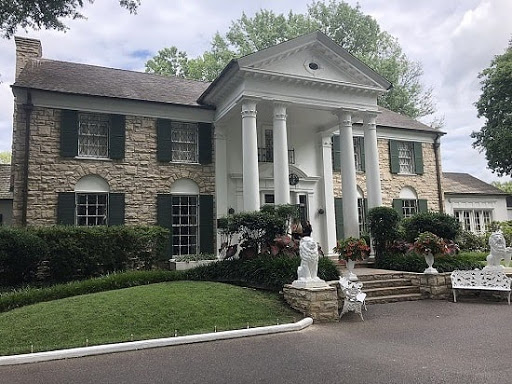 Built in 1939 with a distinctive Colonial Revival style, Graceland is best known as Elvis Presley’s home.
Built in 1939 with a distinctive Colonial Revival style, Graceland is best known as Elvis Presley’s home. Image: Bjoertvedt, CC BY-SA 4.0
The tour of Graceland will take you through the heart of the house, including Elvis's parents' bedroom, the kitchen, the pool room, the Jungle Room, and more. You won't be able to help falling in love with this historic American home.
Sources/Resources:
Texas
Moody Mansion | Galveston, TX
Year Built: 1893-1895
Architectural Style: Richardsonian Romanesque
Architect/Designer: William H. Tyndall
Original Owner: Narcissa Willis
Other Notable Owners: W.L Moody Jr.
Experience Victorian Splendor in the Heart of Texas at the Moody Mansion
The Moody family was one of Texas’s most prominent families at the turn of the 20th century. Their purchase of this 28,000-square-foot mansion in Galveston right after the Great Galveston hurricane of 1900 — the deadliest natural disaster in U.S. history — was proof of their widespread success. Unlike many other historic homes throughout the country, this remained a private residence for the Moody family until 1986. Now, people come from across the country to tour this ornate, spacious home and learn more about the residents who occupied it.
The Moody Mansion, which is a historic landmark, has been restored to its original grandeur. When taking a tour of the mansion, people will be able to see authentic furnishings in their rightful places and personal touches that made this house a home for the Moody family.
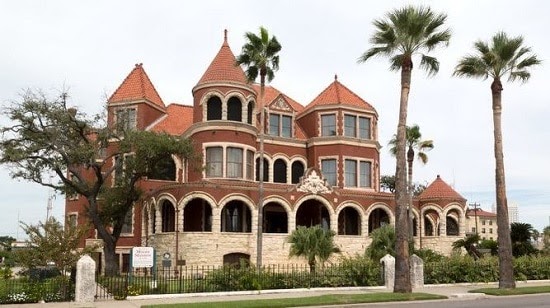 Designed by the British architect William Tyndall in the 1890s, this Victorian-influenced mansion survived the Great Galveston hurricane of 1900 and was purchased by W.L. Moody.
Designed by the British architect William Tyndall in the 1890s, this Victorian-influenced mansion survived the Great Galveston hurricane of 1900 and was purchased by W.L. Moody. Image: Carol M. Highsmith Archive, public domain, Library of Congress, Prints and Photographs Division
Designed by famed British architect William H. Tyndall in the 1890s for another powerful Galveston family, this mansion is one of the best examples of Victorian architecture in Texas. The self-guided tour allows you to explore 20 different rooms of the house. You will see examples of an era gone by from a land far away mixed with the southwestern style that is unique to Texas throughout every room.
Project Row Houses | Houston, TX
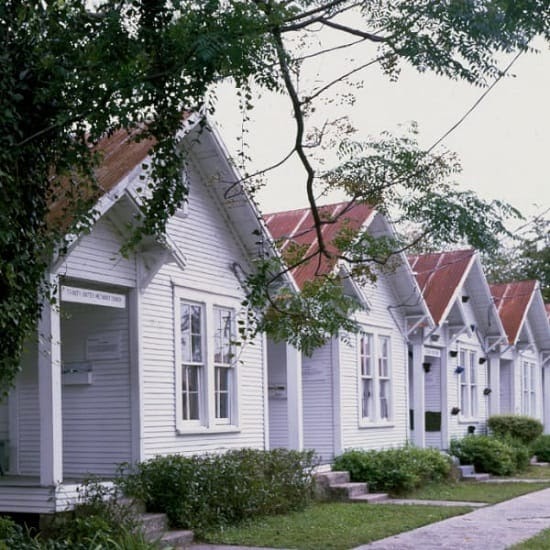 Located in Houston’s historic Third Ward, the first of these shotgun-style houses was built in 1930.
Located in Houston’s historic Third Ward, the first of these shotgun-style houses was built in 1930.Image:Carol M. Highsmith Archive, public domain, Library of Congress, Prints and Photographs Division
Year Built: 1930, restored 1993-1994
Architectural Style: Shotgun Style
Architect/Designer: Project Row Houses/Rice Building Workshop collaboration
Original Owner: Multiple owners
Other Notable Owners: Seven founders of the organization, including James Bettison, Bert Long, Jr., Jesse Lott, Rick Lowe, Floyd Newsum, Bert Samples, and George Smith
Project Row Houses: Empowering People
Project Row Houses (PRH) is less about housing and more about people. It’s an innovative concept that focuses on bringing enrichment through art to an underserved community.
Encompassing five city blocks of Houston's Third Ward, 39 structures -- small homes and small business spaces -- provide innovative and artistic opportunities for enrichment. The multi-faceted project touches lives in unexpected ways. Single mothers envision better futures for their children, struggling small business owners gain confidence and credibility, and creative artists are encouraged to use their talents to benefit others. The results are impressive and can be seen by visiting PRH.
Although centered in the historic Third Ward, the work of PRH extends far beyond neighborhood boundaries, showing that there is an almost limitless possibility for connecting art to life, and fulfilling obvious needs in other ways and other places. The project began in 1993 with a block-and-half of shotgun-style houses, and through a common vision and pooled resources, it has proved to be a powerful vehicle for social transformation.
Sources/Resources:
Wisconsin
Black Point Estate | Lake Geneva, WI
Year Built: 1887-1888
Architectural Style: Queen Anne Victorian
Architect/Designer: Adolph Cudell
Original Owner: Conrad Seipp
Other Notable Owners: Visit Black Point Estate, a True Victorian Time Capsule
Discover the Wharton Esherick Museum - Where Art, Craftsmanship & Fun Combine
Most people may receive a treasured heirloom upon their grandparents’ passing, such as a small decorative item from their home or a valuable piece of jewelry. However, the Seipp Family members received a 20-room mansion with undisturbed views of Wisconsin’s pristine Lake Geneva.
Black Point Estate is one of the so-called “cottages” on Lake Geneva that has survived the test of time throughout the 20th century. While many other Victorian mansions remain along the lake’s shorefront, this Queen Anne Victorian was passed down from one generation to the next until 2005. As a result, the home is a time capsule of sorts — filled with antiquities that date back to the late 19th century.
Today, this mansion and its sprawling gardens are considered one of the country’s best estate tours. Those interested in taking a step back in time and experiencing history for themselves will love the undisturbed beauty of Black Point Estate.
Summary: For many Americans, a lakefront cottage is a quaint yet rustic home that serves as a perfect weekend getaway. The Black Point Estate is no such cottage. This 20-room mansion is one of the finest examples of Queen Anne architecture in the Midwest and is one of the most popular estate tours in the country.
Sources/Resources:


